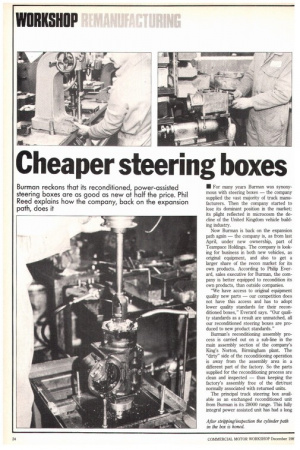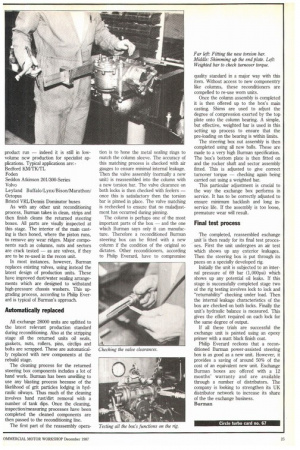Cheaper steering boxes
Page 122

Page 123

If you've noticed an error in this article please click here to report it so we can fix it.
Burman reckons that its reconditioned, power-assisted steering boxes are as good as new at half the price. Phil Reed explains how the company, back on the expansion path, does it
• For many years Burman was synonymous with steering boxes — the company supplied the vast majority of truck manufacturers. Then the company started to lose its dominant position in the market; its plight reflected in microcosm the decline of the United Kingdom vehicle building industry.
Now Burman is back on the expansion path again — the company is, as from Last April, under new ownership, part of Teampace Holdings. The company is looking for business in both new vehicles, as original equipment, and also to get a larger share of the recon market for its own products. According to Philip Everard, sales executive for Burman, the company is better equipped to recondition its own products, than outside companies.
"We have access to original equipment quality new parts — our competition does not have this access and has to adopt lower quality standards for their recon, ditioned boxes," Everard says. "Our quality standards as a result are unmatched, all our reconditioned steering boxes are produced to new product standards."
Burman's reconditioning assembly process is carried out on a sub-line in the main assembly section of the company's King's Norton, Birmingham plant. The "dirty" side of the reconditioning operation is away from the assembly area in a different part of the factory. So the parts supplied for the reconditioning process are clean and inspected — thus keeping the factory's assembly free of the dirt/rust normally associated with returned units.
The principal truck steering box available as an exchanged reconditioned unit from Burman is its 28000 range. This fully integral power assisted unit has had a long
product run — indeed it is still in lowvolume new prodnction for specialist applications. Typical applications are:Bedford KM/TIVTL Foden Seddon Atkinson 201/300-Series Volvo Leyland Buffalo/Lynx/Bison/Marathon/ Octopus Bristol VRL/Dennis Dominator buses As with any other unit reconditioning process, Burman takes in clean, strips and then finish cleans the returned steering boxes. All parts are visully inspected at this stage. The interior of the main casting is then honed, where the piston runs, to remove any wear ridges. Major components such as columns, nuts and sectors are crack tested — as are valves, if they are to be re-used in the recon unit.
In most instances, however, Burman replaces existing valves, using instead the latest design of production units. These have improved dust/water sealing arrangements which are designed to withstand high-pressure chassis washers. This upgrading process, according to Philip Everard is typical of Burman's approach.
Automatically replaced
All exchange 28000 units are upfitted to the latest relevant production standard during reconditioning. Also at the stripping stage all the returned units oil seals, gaskets, nuts, rollers, pins, circlips and bolts are scrapped. These are automatically replaced with new components at the rebuild stage.
The cleaning process for the returned steering box components includes a lot of hand work. Burman has been unwilling to use any blasting process because of the likelihood of grit particles lodging in hydraulic oilways. Thus much of the cleaning involves hand rust/dirt removal with a number of tank dips. Once the cleaning, inspection/measuring processes have been completed the cleaned components are then passed to the reconditioning line.
The first part of the reassembly opera tion is to hone the metal sealing rings to match the column sleeve. The accuracy of this matching process is checked with air gauges to ensure minimal internal leakage. Then the valve assembly (normally a new unit) is reassembled into the column with a new torsion bar. The valve clearance on both locks is then checked with feelers — once this is satisfactory then the torsion bar is pinned in place. The valve matching is rechecked to ensure that no maladjustment has occurred during pinning.
The column is perhaps one of the most important parts of the box — and the one which Burman says only it can manufacture. Therefore a reconditioned Burman steering box can be fitted with a new column if the condition of the original so dictates. Other reconditioners, according to Philip Everard, have to compromise quality standard in a major way with this item. Without access to new componentry like columns, these reconditioners are compelled to re-use worn units.
Once the column assembly is completed it is then offered up to the box's main casting. Shims are used to adjust the degree of compression exerted by the top plate onto the column bearing. A simple, but effective, weighted bar is used in this setting up process to ensure that the pre-loading on the bearing is within limits.
The steering box nut assembly is then completed using all new balls. These are made to a very high Burman specification. The box's bottom plate is then fitted on and the rocker shaft and sector assembly fitted. This is adjusted to give correct turnover torque — checking again being carried out using a weighted bar.
This particular adjustment is crucial to the way the exchange box performs in service. It has to be correctly adjusted to ensure minimum backlash and long inservice life. If the assembly is too loose, premature wear will result.
Final test process
The completed, reassembled exchange unit is then ready for its final test processes. First the unit undergoes an air test which shows up any exterior leakages. Then the steering box is put through its paces on a specially developed rig.
Initially the unit is subjected to an internal pressure of 69 bar (1,000psi) which shows up any potential oil leaks. If this stage is successfully completed stage two of the rig testing involves lock to lock and "returnability" checking under load. Then the internal leakage characteristics of the box are checked on both locks. Finally the unit's hydraulic balance is measured. This gives the effort required on each lack for the same degree of output.
If all these trials are successful the exchange unit is painted using an epoxy primer with a matt black finish coat.
Philip Everard reckons that a reconditioned Burman power-assisted steering box is as good as a new unit. However, it provides a saving of around 50% of the cost of an equivalent new unit. Exchange Burman boxes are offered with a 12 months' warranty and are available through a number of distributors. The company is looking to strengthen its UK distributor network to increase its share of the the exchange business.
Burman








































































































































